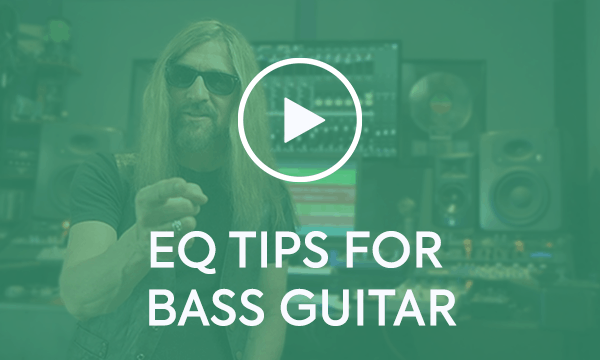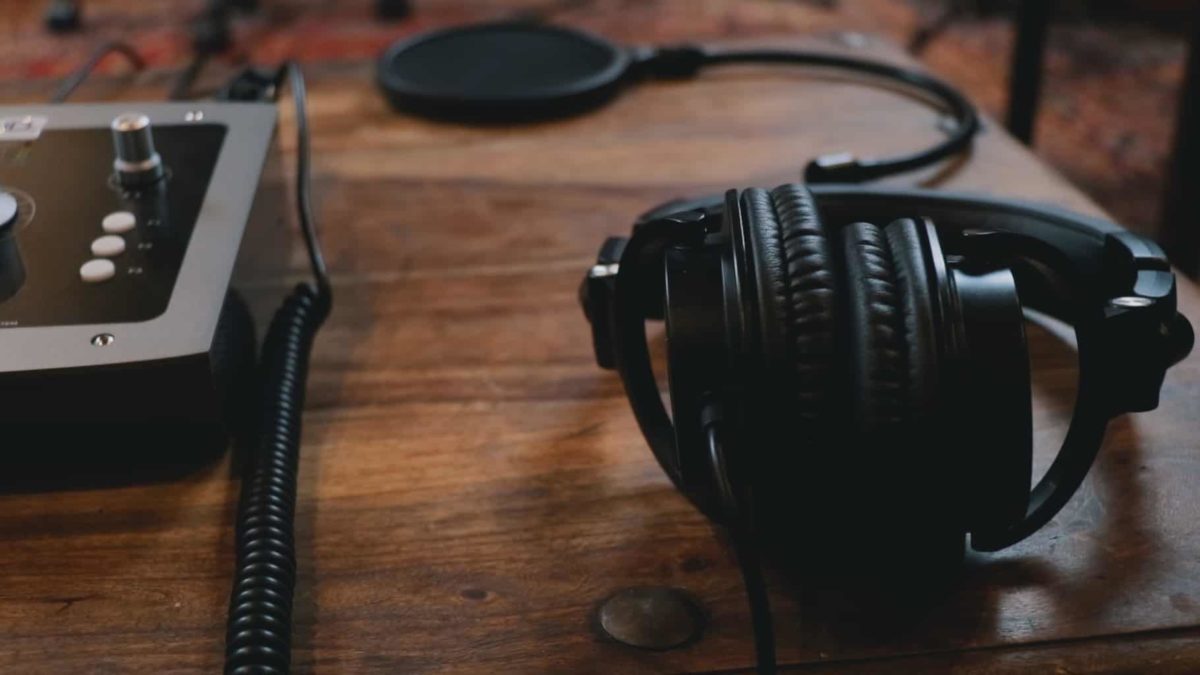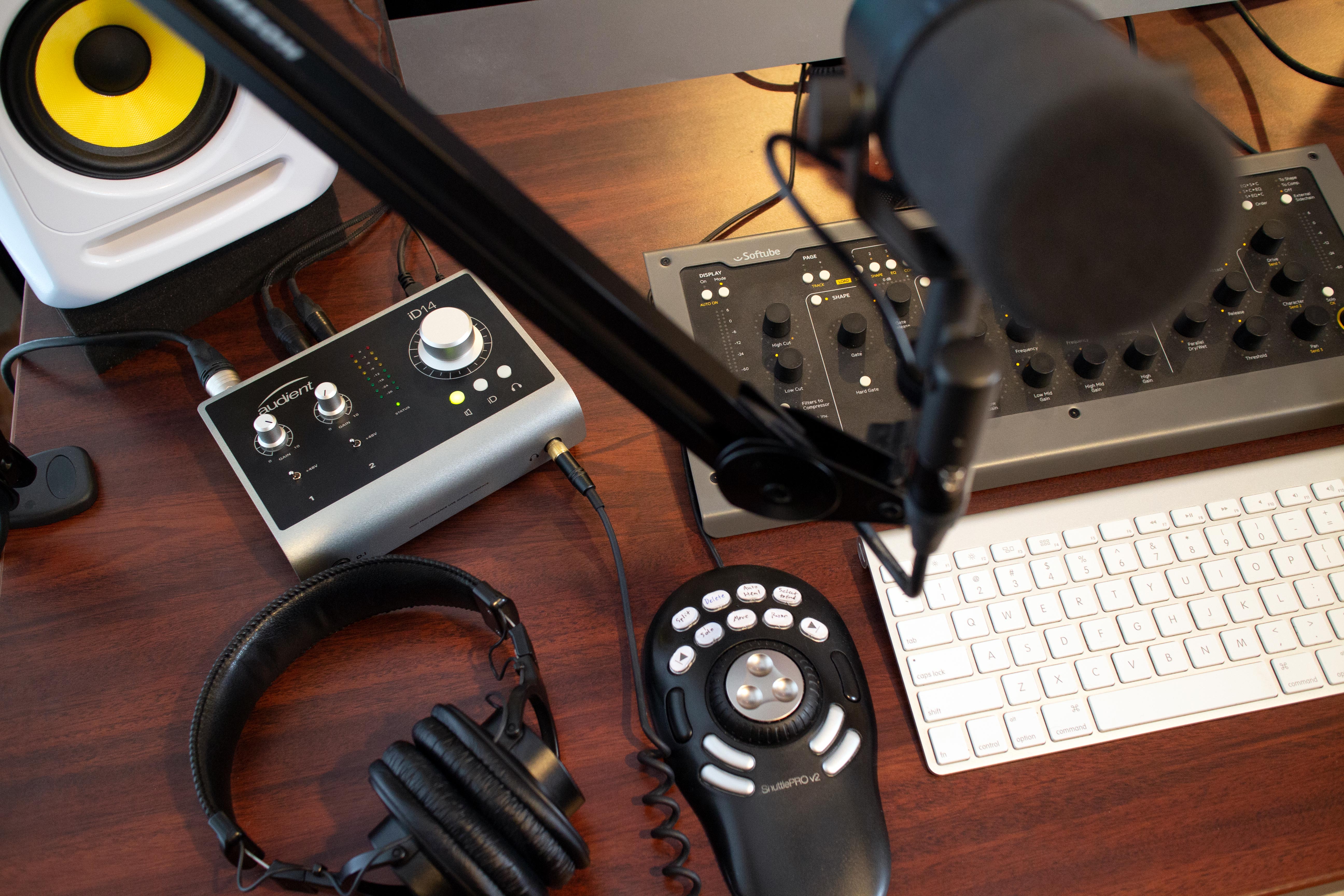Whether it’s you or someone else spitting bars, recording rap vocals to a professional standard in the comfort of your own home is much easier than you probably think – especially if you keep our five empowering tips by your side…

Written by EVO
Get the microphone selection and positioning right
As well as your computer, DAW and EVO audio interface, there are just three other pieces of equipment to budget for in your rap recording endeavours: a microphone, a stand on which to mount it, and a pop shield. While sung vocals are often well-suited to the more sensitive condenser microphone type, for the aggressive delivery of rap, generally speaking, a dynamic mic is the preferred option. With its flattering response and extraordinary durability, the Shure SM58 is always a safe bet. And as for that pop filter, any model will be fine – a tenner should easily cover it.

With your mic on its stand, pointed directly at the vocalist’s mouth, experiment with the distance between the two – the closer the vocalist is to the mic, the more the bass-boosting proximity effect will kick in, so make some test recordings and see what works best for your particular rapper. The pop filter, meanwhile, should be about 6″ in front of the mic.
One of the goals with any vocal recording is to capture it with as little room reverberation as possible. Although there are various ‘reflection filters’ on the market that can help with this in the home studio, they’re only moderately effective, and you’ll get much better results by hanging a couple of duvets in a corner of the room or lining a wardrobe with soft furnishings of any kind to make an impromptu vocal booth.
Prepare the performance
A great performance is obviously essential for any vocal track, but with rap usually involving more in the way of drama and attitude than ‘singing’, getting your MC firing on all cylinders should be considered mission critical. There’s nothing like a well massaged ego to bring the best out in a vocalist, so say whatever you can to boost their confidence and encourage enthusiasm without getting unrealistic, and be positive and constructive with any criticism of the rap they intend to serve up.

When evaluating the performance itself, listen out for enunciation ‘errors’, and get your rapper to cycle through anything that’s imperfectly pronounced, vague or wooly until they nail it perfectly – every word should be clear and distinct. Also, pay very close attention to the lyrics, and if any of them come across as even remotely cliché, unconvincing or awkward, strongly suggest a rewrite of the offending section(s). The last thing you want is to undermine the authenticity of the track with a faltering delivery or poor penmanship.
With all that sorted and the rap 100% ready to go, allow the artist as many run-throughs as they need to prepare themself for the actual take – but sneakily record them while they do it in case it turns out that they perform best without the pressure of the red light.
Comp and edit to perfection
Just about every DAW these days features a comping system, with which multiple cycled takes are stacked up in ‘lanes’ on a single track, then effortlessly spliced together to create a perfect contiguous performance. Be sure to take advantage of this, and get as many takes out of your vocalist as they can manage before fatigue and/or boredom start to set in. If, on the other hand, you’re using a DAW that doesn’t yet facilitate comping, you’ll need to record multiple takes to multiple tracks, then edit it all together onto a ‘master’ track.

Either way, get as microscopic with your comping and editing as required in order to piece together the best possible rap you can, right down to combining syllables from separate takes to optimise individual words, and making the most minute of timing adjustments. Time Stretching and pitch shifting words and syllables isn’t necessarily a no-no, but only as long as you can do it totally transparently – ie, very small changes that no listener could ever realise had been made.
Elevate the track with doubles and ad libs
As well as the main part, you’ll likely want to incorporate double tracks and ad libs into your rap vocal. The latter is largely a matter of getting your rapper vibing with the vocal they’ve already laid down, and recording their spontaneous (or planned) improvisations onto a separate track for mixing in as required. However, there’s rather more to vocal doubles, as they require accurate duplication – and even triplication or beyond – of the main vocal, which some rappers will be better at than others. Of course, your DAW gives you all the tools required to precisely tighten up stacks of vocals manually, but if you work with rap (or sung) vocals a lot, SynchroArts’ VocAlign Ultra plugin is well worth trying out for its quasi-magical ability to automatically align multitrack vocals in both the time and pitch domains.

When mixing doubles and ad libs, be wary of overwhelming the main rap; and make use of the stereo field, spreading double tracks for an overall impression of width, and placing ad libs to the left and/or right of centre so that they come across as supportive rather than focal.
Shape the sound with compression and EQ
A good rap vocal should be upfront and dynamically consistent, and the key to achieving that is compression. Set your compressor’s ratio moderately high, tweak the attack and release times to control the punch and density of the sound, and try overdriving the input a little to introduce the slightest touch of distortion.

Equalisation is also an important part of the process, and while its specific application will depend on the individual qualities of your rapper’s voice, certain frequency ranges are pretty much universal in their contributions: 20-90Hz for rumble, 90-300Hz for the fundamental, 250-600Hz for ‘muddiness’, 1-4kHz for presence, 5-8kHz for sibilance, and 8-20kHz for ‘air’. This is a subject we’ll return to in greater depth in a future article.
Finally, steer clear of reverb, delay and other ‘wet’ effects when mixing rap vocals, except perhaps in very small amounts, and/or on ad libs and doubles, as clarity and intelligibility simply mustn’t be compromised.
Related Articles
Whether it’s you or someone else spitting bars, recording rap vocals to a professional standard in the comfort of your own home is much easier than you probably think – especially if you keep our five empowering tips by your side…

Written by EVO
Get the microphone selection and positioning right
As well as your computer, DAW and EVO audio interface, there are just three other pieces of equipment to budget for in your rap recording endeavours: a microphone, a stand on which to mount it, and a pop shield. While sung vocals are often well-suited to the more sensitive condenser microphone type, for the aggressive delivery of rap, generally speaking, a dynamic mic is the preferred option. With its flattering response and extraordinary durability, the Shure SM58 is always a safe bet. And as for that pop filter, any model will be fine – a tenner should easily cover it.

With your mic on its stand, pointed directly at the vocalist’s mouth, experiment with the distance between the two – the closer the vocalist is to the mic, the more the bass-boosting proximity effect will kick in, so make some test recordings and see what works best for your particular rapper. The pop filter, meanwhile, should be about 6″ in front of the mic.
One of the goals with any vocal recording is to capture it with as little room reverberation as possible. Although there are various ‘reflection filters’ on the market that can help with this in the home studio, they’re only moderately effective, and you’ll get much better results by hanging a couple of duvets in a corner of the room or lining a wardrobe with soft furnishings of any kind to make an impromptu vocal booth.
Prepare the performance
A great performance is obviously essential for any vocal track, but with rap usually involving more in the way of drama and attitude than ‘singing’, getting your MC firing on all cylinders should be considered mission critical. There’s nothing like a well massaged ego to bring the best out in a vocalist, so say whatever you can to boost their confidence and encourage enthusiasm without getting unrealistic, and be positive and constructive with any criticism of the rap they intend to serve up.

When evaluating the performance itself, listen out for enunciation ‘errors’, and get your rapper to cycle through anything that’s imperfectly pronounced, vague or wooly until they nail it perfectly – every word should be clear and distinct. Also, pay very close attention to the lyrics, and if any of them come across as even remotely cliché, unconvincing or awkward, strongly suggest a rewrite of the offending section(s). The last thing you want is to undermine the authenticity of the track with a faltering delivery or poor penmanship.
With all that sorted and the rap 100% ready to go, allow the artist as many run-throughs as they need to prepare themself for the actual take – but sneakily record them while they do it in case it turns out that they perform best without the pressure of the red light.
Comp and edit to perfection
Just about every DAW these days features a comping system, with which multiple cycled takes are stacked up in ‘lanes’ on a single track, then effortlessly spliced together to create a perfect contiguous performance. Be sure to take advantage of this, and get as many takes out of your vocalist as they can manage before fatigue and/or boredom start to set in. If, on the other hand, you’re using a DAW that doesn’t yet facilitate comping, you’ll need to record multiple takes to multiple tracks, then edit it all together onto a ‘master’ track.

Either way, get as microscopic with your comping and editing as required in order to piece together the best possible rap you can, right down to combining syllables from separate takes to optimise individual words, and making the most minute of timing adjustments. Time Stretching and pitch shifting words and syllables isn’t necessarily a no-no, but only as long as you can do it totally transparently – ie, very small changes that no listener could ever realise had been made.
Elevate the track with doubles and ad libs
As well as the main part, you’ll likely want to incorporate double tracks and ad libs into your rap vocal. The latter is largely a matter of getting your rapper vibing with the vocal they’ve already laid down, and recording their spontaneous (or planned) improvisations onto a separate track for mixing in as required. However, there’s rather more to vocal doubles, as they require accurate duplication – and even triplication or beyond – of the main vocal, which some rappers will be better at than others. Of course, your DAW gives you all the tools required to precisely tighten up stacks of vocals manually, but if you work with rap (or sung) vocals a lot, SynchroArts’ VocAlign Ultra plugin is well worth trying out for its quasi-magical ability to automatically align multitrack vocals in both the time and pitch domains.

When mixing doubles and ad libs, be wary of overwhelming the main rap; and make use of the stereo field, spreading double tracks for an overall impression of width, and placing ad libs to the left and/or right of centre so that they come across as supportive rather than focal.
Shape the sound with compression and EQ
A good rap vocal should be upfront and dynamically consistent, and the key to achieving that is compression. Set your compressor’s ratio moderately high, tweak the attack and release times to control the punch and density of the sound, and try overdriving the input a little to introduce the slightest touch of distortion.

Equalisation is also an important part of the process, and while its specific application will depend on the individual qualities of your rapper’s voice, certain frequency ranges are pretty much universal in their contributions: 20-90Hz for rumble, 90-300Hz for the fundamental, 250-600Hz for ‘muddiness’, 1-4kHz for presence, 5-8kHz for sibilance, and 8-20kHz for ‘air’. This is a subject we’ll return to in greater depth in a future article.
Finally, steer clear of reverb, delay and other ‘wet’ effects when mixing rap vocals, except perhaps in very small amounts, and/or on ad libs and doubles, as clarity and intelligibility simply mustn’t be compromised.





